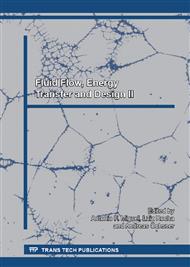[1]
G. Chen, D. Borca-Tasciuc, R.G. Yang, Nanoscale Heat Transfer, in: H.S. Nalwa (Eds. ), Encyclopedia of NanoScience and Nanotechnology, American Scientific Publishers, Valencia, California, 2004, p.429–459: http: /www. aspbs. com/enn.
Google Scholar
[2]
Z. M . Zhang, Nano/microscale heat transfer, first ed., McGraw-Hill, New York, (2007).
Google Scholar
[3]
A.N. Smith, P.M. Norris, Microscale heat transfer, in: A. Bejan, D. Kraus (Eds. ), Heat Transfer Handbook, John Wiley & Sons, New Jersey, 2003, 1309-1359.
Google Scholar
[4]
R.A. Escobar, S.S. Ghai, M.S. Jhon, C.H. Amon, Multi-length and time scale thermal transport using the lattice Boltzmann method with application to electronic cooling, International Journal of Heat and Mass Transfer, 49 (2006) 97-107.
DOI: 10.1016/j.ijheatmasstransfer.2005.08.003
Google Scholar
[5]
C. Cattaneo, A form of heat conduction equation which eliminates the paradox of instantaneous propagation, Comp. Rend., 247 (1958) 431-433.
Google Scholar
[6]
P. Vernotte, Les paradoxes de la theorie continue de l'equation de la chaleur, Comp. Rend., 246 (1958) 3154-3155.
Google Scholar
[7]
D.Y. Tzou, A unified approach for heat conduction from macro- to micro-scale, ASME Journal of Heat Transfer, 117 (1995) 8-16.
DOI: 10.1115/1.2822329
Google Scholar
[8]
D.Y. Tzou, Macro- to Microscale Heat Transfer: The lagging behaviour, first ed., Taylor and Francis, Washington, (1997).
Google Scholar
[9]
J. Shiomi, S. Maruyama. Non-fourier heat conduction in a single-walled carbon nanotube: Classical molecular dynamics simulations, Physical Review B, 73 (2006) 205420-1-205420-7.
DOI: 10.1103/physrevb.73.205420
Google Scholar
[10]
J. Ghazanfarian, A. Abbassi, Effect of boundary phonon scattering on dual-phase-lag model to simulate micro- and nano-scale heat conduction, International Journal of Heat and Mass Transfer, 52 (2009) 3706-3711.
DOI: 10.1016/j.ijheatmasstransfer.2009.01.046
Google Scholar
[11]
M.A. Al-Nimr, Heat transfer mechanisms during short duration laser heating of thin metal films, International Journal of Thermophysics, 18 (1997) 1257-1268.
DOI: 10.1007/bf02575260
Google Scholar
[12]
Z. Lin, L.V. Zhigilei, Electron-phonon coupling and electron heat capacity of metals unde conditions of strong electron-phonon nonequilibrium, Physical Review, B, 77 (2008) 075133-1-075133-17.
DOI: 10.1103/physrevb.77.075133
Google Scholar
[13]
E. Majchrzak, B. Mochnacki, A.L. Greer, J.S. Suchy, Numerical modeling of short pulse laser interactions with multi-layered thin metal films, CMES: Computer Modeling in Engineering and Sciences, 41 (2009) 131-146.
Google Scholar
[14]
T.Q. Qiu, C.L. Tien, Femtosecond laser heating of multi-layer metals – I. Analysis, International Journal of Heat and Mass Transfer, 37 (1994) 2789-2797.
DOI: 10.1016/0017-9310(94)90396-4
Google Scholar
[15]
W. Tian, R. Yang, Phonon transport and thermal conductivity percolation in random nanoparticle composites, CMES: Computer Modeling in Engineering & Sciences, 24 (2008) 123-142.
Google Scholar
[16]
M. Xu, L. Wang, Dual-phase-lagging heat conduction based on Boltzmann transport equation, International Journal of Heat and Mass Transfer, 48 (2005) 5616-5624.
DOI: 10.1016/j.ijheatmasstransfer.2005.05.040
Google Scholar
[17]
R. A Escobar, C.H. Amon, Thin film phonon heat conduction by the dispersion lattice Boltzmann method, Journal of Heat Transfer, 130 (2008) 092402-1-092402-8.
DOI: 10.1115/1.2944249
Google Scholar
[18]
T.C. Theodosiou, D.A. Saravanos, Molecular mechanics based finite element for carbon nanotube modeling, CMES: Computer Modeling in Engineering & Sciences, 19 (2007) 121-134.
DOI: 10.1115/caneus2006-11062
Google Scholar
[19]
S. Maruyama, A molecular dynamics simulation of heat conduction of a finite length single-walled carbon nanotube, Microscale Thermophysical Engineering, 7 (2003) 41–50.
DOI: 10.1080/10893950390150467
Google Scholar
[20]
M. Kaviany, Heat transfer physics, second ed., University Press, Cambridge, (2014).
Google Scholar
[21]
M.A. Garisson Darin, J.L. Barth (Eds), Systems Engineering for Microscale and Nanoscale Technologies, first ed., Taylor & Francis Group, Abingdon, (2012).
Google Scholar
[22]
S. Voltz (Eds. ), Thermal Nanosystems and Nanomaterials, first ed., Springer-Verlag, Heildelberg, (2009).
Google Scholar
[23]
J.K. Chen, J.E. Beraun, Numerical study of ultrashort laser pulse interactions with metal films. Numerical Heat Transfer. Part A, 40 (2001) 1-20.
DOI: 10.1080/104077801300348842
Google Scholar
[24]
M. Kleiber, Parameter sensitivity, first ed., J. Wiley & Sons Ltd., Chichester, (1997).
Google Scholar
[25]
E. Majchrzak, B. Mochnacki, Sensitivity analysis of transient temperature field in microdomains with respect to the dual phase lag model parameters, International Journal for Multiscale Computational Engineering, 12 (2014) 65-77.
DOI: 10.1615/intjmultcompeng.2014007815
Google Scholar
[26]
E. Majchrzak, J. Dziatkiewicz, G. Kałuża, Application of sensitivity analysis in microscale heat transfer, Computer Assisted Methods in Engineering and Science, 20 (2013) 113-121.
Google Scholar
[27]
K. Kurpisz, A.J. Nowak, Inverse Thermal Problems, first ed., Computational Mechanics Publications, Southampton-Boston, (1995).
Google Scholar
[28]
T. Burczyński, Sensitivity analysis, optimization and inverse problems, in: D. Beskos, G. Maier (Eds. ), Boundary element advances in solid mechanics, Springer Verlag, Vien, New York, 2003, pp.245-307.
DOI: 10.1007/978-3-7091-2790-2_6
Google Scholar
[29]
E. Majchrzak, B. Mochnacki, Identification of thermal properties of the system casting-mould, Materials Science Forum, 539-543 (2007) 2491-2498.
DOI: 10.4028/www.scientific.net/msf.539-543.2491
Google Scholar
[30]
W. Dai, R. Nassar, A compact finite difference scheme for solving a one-dimensional heat transport equation at the microscale, Journal of Computational and Applied Mathematics, 132 (2001) 431-441.
DOI: 10.1016/s0377-0427(00)00445-3
Google Scholar
[31]
J. Dziatkiewicz, W. Kuś. E. Majchrzak, T. Burczyński, Ł. Turchan, Bioinspired identification of parameters in microscale heat transfer, International Journal for Multiscale Computational Engineering, 12 (2014) 79-89.
DOI: 10.1615/intjmultcompeng.2014007963
Google Scholar
[32]
E. Majchrzak, J. Dziatkiewicz, Identification of electron-phonon coupling factor in a thin metal film subjected to an ultrashort laser pulse, Computer Assisted Methods in Engineering and Science, 19 (2012) 383-392.
Google Scholar


